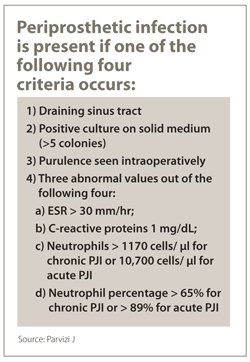When in doubt, aspirate the joint: A new diagnostic criterion for periprosthetic joint infection
Performing joint aspirations can identify patients with infection who were erroneously categorized as ‘aseptic failures.’
by Javad Parvizi, MD, FRCSC
Periprosthetic joint infection poses challenges on many fronts, one of which is the difficulty in reaching a diagnosis. While isolation of organisms from the fluid and tissue cultures have traditionally been considered the gold standard, false positive and false negative results occur in 5% to 37% and 2% to 18% of cases, respectively. Relying on successful isolation of an organism in order to diagnose infection, then, is not an accurate diagnostic standard.
There are a number of reasons that may explain the low accuracy observed with culture. One, and perhaps the most important, is the ability of infecting organisms to form a biofilm and not be planktonic, making it difficult to isolate them from fluid or culture samples. Administration of antibiotics can also interfere with the isolation of infecting organisms. Finally, culture techniques can only isolate common pathogenic organisms, and less common pathogens may not be isolated in standard growth media.
|
|
No test

The lack of an absolute test for diagnosis of periprosthetic joint infection (PJI) has led the medical community to design diagnostic criteria which take into account various clinical and laboratory parameters. There are a number of these criteria in use at the present time, most of which appear to provide a valuable guide for the evaluation of a patient with a failed joint. Although variation exists, the majority of them rely on the results of joint aspiration or deep tissue culture; serological tests, namely erythrocyte sedimentation rate (ESR), C-reactive protein (CRP); the appearance of joint during surgery (with regard to presence of purulence), presence or absence of a sinus tract, and the result of histological analysis of tissue obtained during surgery (frozen section).
The frozen section operates on the assumption that infection leads to migration and proliferation of acute inflammatory cells, neutrophils, in the infected joint. This is indeed the case. Many studies have shown that there is a high number of neutrophils and a higher percentage of these cells in infected joints. More sophisticated studies, including some at our center, have led to the isolation of molecular markers — the products of neutrophils — which may be used as biomarkers of PJI. Work on this front is ongoing.
Joint fluid analysis
In recent years there have been numerous studies demonstrating the value of joint fluid analysis with respect to cell counts and neutrophil percentages. At our center, we have been investigating the role of joint aspirate analysis for a few years. Previous studies have observed that aspirate white cell counts of 1,100 to 3,000 cells/µl and neutrophil percentages of 60% to 73% can be used with high accuracy as thresholds for diagnosis of nonacute infection. In a separate study, we have also observed that these thresholds are markedly elevated in the acute postoperative period, with thresholds of 10,700 cells/µl for synovial cell counts and 89% for PMN%, providing 92% accuracy in diagnosis of acute PJI.
Therefore, one could argue that addition of the results of joint aspirate analysis to previously described diagnostic criteria would improve the accuracy of those criteria. Moreover, doing so would identify patients with infection who were erroneously categorized as “aseptic failures.” This happens to be the case. Over the last 3 years, we have used joint aspirate analysis as diagnostic criteria at our center (Table). Based on our experience we strongly recommend that knee joint aspiration be a routine part of clinical investigation for patients undergoing revision arthroplasty. The joint aspirate should be sent for culture, cell count, and neutrophil percentage, as this combination analysis provides invaluable information in work up of these patients.
References:
- Bauer TW, Parvizi J, Kobayashi N, Krebs V. Diagnosis of periprosthetic infection. J Bone Joint Surg Am. 2006;88(4):869-882.
- Della Valle CJ, Sporer SM, Jacobs JJ, et al. Preoperative testing for sepsis before revision total knee arthroplasty. J Arthroplasty. 2007;22(6 Suppl 2):90-93.
- Fehring TK, McAlister Jr JA. Frozen histologic section as a guide to sepsis in revision joint arthroplasty. Clin Orthop Relat Res. 1994;(304):229-237.
- Ghanem E, Parvizi J, Burnett RS, et al. Cell count and differential of aspirated fluid in the diagnosis of infection at the site of total knee arthroplasty. J Bone Joint Surg Am. 2008;90(8):1637-1643.
- Parvizi J, Ghanem E, Sharkey P, et al. Diagnosis of infected total knee: findings of a multicenter database. Clin Orthop Relat Res. 2008;466(11):2628-2633.
- Javad Parvizi, MD, FRCSC, can be reached at Rothman Institute of Orthopaedics at Jefferson, 925 Chestnut St., 2nd Floor, Philadelphia, PA 19107; 267-399-3617; e-mail: parvj@aol.com.



